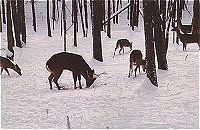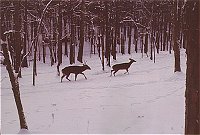
|
Features
|
|
|
|
Book Selections
|
|
Fun & Games
|
|
Contact Us
|
| Click on Images to Enlarge |
 |
CHAPTER 8
TRACK
TROPHY BUCKS IN THE SNOW
Norman LeBrun must have known these winding Canadian woods roads as well as his mother's face. At least I hoped he did. He was speeding his old green pickup over the freshly fallen snow like Dale Earnhardt banking into the pits at Darlington.
But as we reached our hunting area, his mood changed. He slowed down the truck and focused on the edge of the road. The conditions were ideal for tracking. Before long the truck came to a halt. LeBrun walked to the front of the truck and hunkered down toward the snow. We had cut a set of deer tracks.
Canadian Tactics
"That's a buck track, and he's moving slowly," LeBrun said, his pleasant accent revealing his French-Canadian roots. "We can catch him in 15 minutes or so."
"Say what?" I thought to myself LeBrun must have assumed I was a novice. Everyone knew you couldn't tell the sex of a deer by looking at its track, and you certainly couldn't tell how far away it was. I decided LeBrun was just trying to give me an anecdote for my story. Being the good reporter, I played along.
"So, Norman, exactly how can you tell so much from that track?" I asked, carefully adding a bit of skepticism, perhaps even sarcasm, to my voice.
But LeBrun was all business as he answered, "See how the deer drags his toes as he lifts his foot to walk? Bucks make this kind of track, not does. Usually when you see a track with the back toes dragging, the deer will be a buck.
"We can be sure the deer went across the road after the snow stopped falling, and he can't be more than 15 minutes in front of us if he keeps going at the same pace. But if we stand here and continue to talk, we may not catch up to that buck until next week. If you want to kill a buck, get your gun, and let's go."
 I
loaded my .243 and checked my riflescope to be sure it was clear of snow.
I
loaded my .243 and checked my riflescope to be sure it was clear of snow.
LeBrun had begun to move away from the road and into the evergreens. I looked at my watch and saw the time was 2:15 p.m. LeBrun, moving deliberately, stalked quickly through the snow, hardly looking at the track as he kept pace. Then he froze.
"There he is," LeBrun whispered.
The buck stood about 50 yards away in the trees, quartering ahead slightly and looking in the other direction. Before I brought my rifle to my shoulder, I turned my wrist and saw the time was 2:33 p.m. I brought the scope up and could tell the buck was at least an 8 pointer, perhaps a 9 pointer. I slowly brought the crosshairs just behind the animal's shoulder and squeezed the trigger. The deer bolted only a few yards before piling up in the snow.
"I thought you said we only needed 15 minutes to catch up to the deer," I quipped, offering a kidding compliment. "By my watch, 18 minutes passed before we reached the deer."
LeBrun looked up with a big smile as he bent over the downed animal. "If you hadn't wasted so much time asking me so many questions and getting your gear out of the truck, we would have caught up to this deer in 10 minutes!"
I laughed. I learned never to try to outsmart the veteran guide of Anticosti Island. LeBrun was intimately familiar with Anticosti, a large patch of land rising above the Gulf of St. Lawrence in eastern Quebec, Canada. The island has become famous for its whitetail hunting and two- deer limit. We dressed and dragged the deer back to the truck and loaded it. We still had several hours of daylight left, and LeBrun suggested we find another buck.
An hour or so later we came across a place where four deer had walked across a clearing in the spruce forest. As LeBrun studied the tracks, he looked up at me and asked, "This one is a buck track. Can you tell?"
 The
dragging hoof mark was obvious among the three doe tracks. I nodded and
smiled, and the hunt was on. An hour later we caught up to a nice 6 pointer.
Once again, when my rifle reported, the buck fell in the snow. This time,
LeBrun had misjudged the time required to kill the deer by only 10 minutes.
Since LeBrun knew I was keeping track, his excuse this time came voluntarily.
The
dragging hoof mark was obvious among the three doe tracks. I nodded and
smiled, and the hunt was on. An hour later we caught up to a nice 6 pointer.
Once again, when my rifle reported, the buck fell in the snow. This time,
LeBrun had misjudged the time required to kill the deer by only 10 minutes.
Since LeBrun knew I was keeping track, his excuse this time came voluntarily.
"The snow was deep," LeBrun said. "But I thought you would be able to move through it quicker than you did."
We dragged the deer out of the dark forest and loaded it in the pickup next to the first. Then we took another wild ride down the snowy back roads.
Back home in Alabama, I never had the opportunity to do much snow tracking. The premise of finding and sneaking up on a mature whitetail buck seemed unlikely. But in hindsight, the skills involved in tracking were logical. LeBrun was a master; his precision in interpreting the tracks was obviously honed by vast experience.
"I've hunted deer all my life and guided hunters on Anticosti for 20 years," LeBrun said. "I work seven days a week for three months guiding hunters and trying to find deer. The little things -- the details I find in the snow -- help me determine the size and sex of the deer and how fast we can catch up with it."
LeBrun also uses the forest and weather conditions to fullest advantage.
"One reason I could tell how quickly we could get to the deer was because there was some wind today," he said. "The wind caused the trees to rattle their branches, knocking the snow off. All that rattling and even the thud of the snow covered the sound of our footsteps. Because everything else in the woods moved, I didn't think the deer would be spooked even if they saw us. I knew we could move swiftly to the bucks and get them in a hurry -- if you could shoot straight."
Tracking deer is not a technique for the impatient nor for the hunter who only spends three or four days a season in the woods. Recognizing the subtle clues and developing the almost sixth sense good trackers possess comes from lifetimes in the woods.
|
How To Order CALL or Send check or money order to: Night Hawk Publications *All Alaskan orders add $8 for each book ordered. *All Canadian orders add $3 for each book ordered and use International
Money Order |

